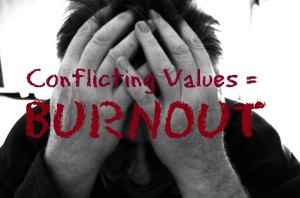
Everyone has a set of core values which guide them in life and in their everyday interactions with others. If you work for an organization, you bring those values with you into the workplace. Warning: the creation of conflicting values in the workplace can put employees on the fast track to job related burnout.
Recently, I began reviewing the 6 mismatches between the job and the individual which can lead to job related burnout and writing a post on each of them in a series. The sixth and last mismatch in this series, conflicting values, is the subject of today’s post.
Out of all the mismatches between the nature of a job and the nature of the person doing the job, conflicting values probably carries the most weight. If an individual finds themselves in a job where there is substantial conflict between the demands of the job and their core values, there will exist great potential for job related burnout.
If an organization, say a large hospital, provider group, or business touts excellent service but behind the scenes the employees know this is not true then substantial internal conflict will arise. If an organization’s value statement stresses honesty but honest employees witness or are made to participate in dishonest or underhanded business practices, then internal conflict results.
This can be extremely frustrating and demoralizing to the employees, especially when their internal moral compass or core values are being assailed. True, most organizations do not go out of their way to create values conflicts, but it happens. This is often unplanned and can develop very innocently.
Organizations may emphasize dedicated and excellent service but inadvertently take steps which actually destroy their ability to deliver a quality product or service. While attempting to improve customer service, greater distance can be put between the patient, client or customer and the organization. Examples are automated phone menus, teller machines, information kiosks, online-only ordering, patient information portals, etc. Shorter wait times at the doctor’s office might be great but not if they are at the expense of adequate time with the provider.
Consider this, if you are the patient and have a problem or a complaint, would you want to be directed to an online questionnaire or would you prefer to sit down and voice the issue with another human being? The online questionnaire might be more expeditious for the organization but does it really demonstrate next level quality or service?
In her book, The Truth About Burnout, Dr. Christina Maslach identified four primary guiding values for excellence in customer service. They are – be efficient, be accurate, be personal and be adaptable to the individual. Does this sound like many large organizations and businesses today?
No matter how great an organizations’ values statement may sound, it isn’t worth the paper it is printed on if each of these guiding values are not fully addressed in the everyday course of business. If there is conflict between an organizations stated values and the organization’s performance, the employees will take notice and so will the people they serve.
We have also recently seen a glaring example where an organization publicly states “we care” while behind the scenes overtly demonstrate how they couldn’t have cared less. I’m talking about the VA healthcare scandal.
People were being purposefully lied to in order to make certain internal metrics look good while actively projecting the persona of “we care very deeply about our veterans but we are just too short staffed and lack necessary resources to see you in the most timely manner.”
How many great, competent and caring staff did the VA frustrate, burnout or drive away over the years because behind the scenes the truth was known to them? Those who could not at all abide the internal conflicts this situation created simply left. This resulted in a substantial loss of talent which further degraded the organization.
How many labored on not knowing the truth, hoping that something would change, doing their best under the circumstances but unable to deliver their best work to the veterans for which they cared so deeply? This was a tragedy for them as well.
Any who remained and actively participated in this sham showed their internal vales to be on par with the hideous lies which were told. Hence, as amoral as they were, they saw no conflict between themselves and the organization.
You know, it just doesn’t have to be this way. There are many steps an organization can take to ensure the values they espouse are true and emulate the values of the workforce.
Do you feel the values of organization for which you work reflect your own internal values? If not, how are they different?
Let me know what you think. Or, if you would like to discuss this privately email me at drburnout@clarkgaither.com or call me at 919-735-1251 and ask for Faye or Hope.